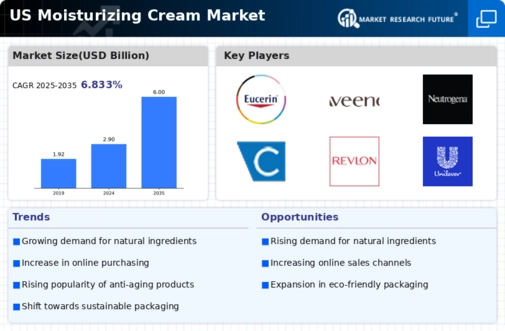Increasing Awareness of Skin Health
The growing awareness of skin health among consumers is a pivotal driver in the moisturizing cream market. As individuals become more informed about the importance of skincare, they are increasingly seeking products that offer hydration and nourishment. This trend is reflected in the rising sales figures, with the moisturizing cream market experiencing a growth rate of approximately 5.5% annually. Consumers are now more inclined to invest in high-quality moisturizing creams that promise effective results, leading to a surge in demand for products that cater to various skin types and concerns. The emphasis on skin health is further supported by dermatologists and skincare professionals advocating for proper hydration as a fundamental aspect of skincare routines. Consequently, this heightened awareness is likely to continue influencing purchasing decisions, thereby propelling the moisturizing cream market forward.
Innovations in Product Formulations
Innovations in product formulations are significantly shaping the moisturizing cream market. Manufacturers are increasingly focusing on developing advanced formulations that incorporate cutting-edge ingredients, such as hyaluronic acid, peptides, and botanical extracts. These innovations not only enhance the efficacy of moisturizing creams but also cater to specific skin concerns, such as aging, dryness, and sensitivity. The introduction of multifunctional products that combine moisturizing properties with sun protection or anti-aging benefits is particularly appealing to consumers. As a result, the market is witnessing a diversification of product offerings, which is expected to drive growth. In 2025, the moisturizing cream market is projected to reach a valuation of over $10 billion, underscoring the impact of innovative formulations on consumer preferences and market dynamics.
Rising Demand for Anti-Aging Products
The increasing demand for anti-aging products is a notable driver in the moisturizing cream market. As the population ages, particularly among the baby boomer generation, there is a heightened focus on maintaining youthful skin. This demographic is actively seeking moisturizing creams that not only hydrate but also provide anti-aging benefits, such as reducing fine lines and improving skin elasticity. The moisturizing cream market is responding to this demand by offering products specifically formulated with anti-aging ingredients, which are gaining popularity among consumers. Market Research Future indicates that anti-aging products account for a substantial share of the overall skincare market, with projections suggesting that this segment will continue to expand. Consequently, the emphasis on anti-aging solutions is likely to propel the growth of the moisturizing cream market in the coming years.
Sustainability and Eco-Friendly Products
Sustainability and eco-friendly products are becoming increasingly important in the moisturizing cream market. Consumers are now more conscious of the environmental impact of their purchases, leading to a demand for products that are not only effective but also environmentally responsible. Brands that prioritize sustainable sourcing, eco-friendly packaging, and cruelty-free practices are likely to attract a growing segment of environmentally aware consumers. This shift towards sustainability is reflected in market trends, with a notable increase in the availability of organic and natural moisturizing creams. As the market evolves, companies that align their product offerings with sustainability principles may gain a competitive edge. The moisturizing cream market is thus poised for growth as consumers seek out products that reflect their values and commitment to environmental stewardship.
Influence of Social Media and Beauty Influencers
The influence of social media and beauty influencers is reshaping consumer behavior in the moisturizing cream market. Platforms such as Instagram and TikTok have become vital channels for beauty brands to engage with consumers, showcasing products through tutorials, reviews, and endorsements. This trend has led to increased visibility for various moisturizing creams, driving consumer interest and purchases. Influencers often highlight the benefits of specific products, creating a sense of trust and authenticity that resonates with their followers. As a result, brands that effectively leverage social media marketing strategies are likely to see a boost in sales. The moisturizing cream market is expected to benefit from this trend, as consumers increasingly turn to online platforms for skincare recommendations and product discovery.






















Leave a Comment